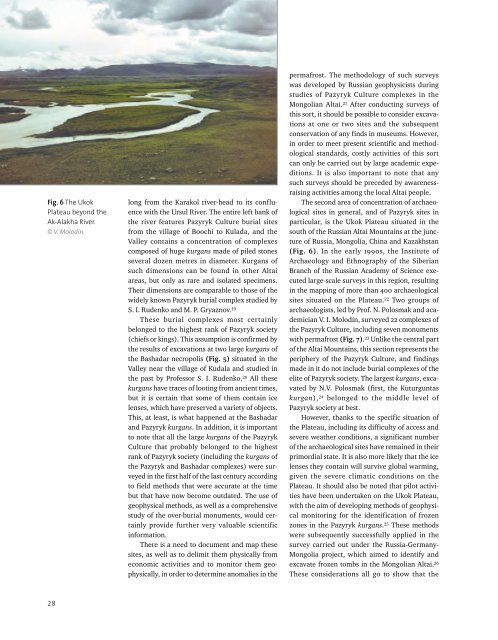Scythian Culture - Preservation of The Frozen Tombs of The Altai Mountains (UNESCO)
Create successful ePaper yourself
Turn your PDF publications into a flip-book with our unique Google optimized e-Paper software.
Fig. 6 <strong>The</strong> Ukok<br />
Plateau beyond the<br />
Ak-Alakha River.<br />
© V. Molodin.<br />
long from the Karakol river-head to its confluence<br />
with the Ursul River. <strong>The</strong> entire left bank <strong>of</strong><br />
the river features Pazyryk <strong>Culture</strong> burial sites<br />
from the village <strong>of</strong> Boochi to Kulada, and the<br />
Valley contains a concentration <strong>of</strong> complexes<br />
composed <strong>of</strong> huge kurgans made <strong>of</strong> piled stones<br />
several dozen metres in diameter. Kurgans <strong>of</strong><br />
such dimensions can be found in other <strong>Altai</strong><br />
areas, but only as rare and isolated specimens.<br />
<strong>The</strong>ir dimensions are comparable to those <strong>of</strong> the<br />
widely known Pazyryk burial complex studied by<br />
S. I. Rudenko and M. P. Gryaznov. 19<br />
<strong>The</strong>se burial complexes most certainly<br />
belonged to the highest rank <strong>of</strong> Pazyryk society<br />
(chiefs or kings). This assumption is confirmed by<br />
the results <strong>of</strong> excavations at two large kurgans <strong>of</strong><br />
the Bashadar necropolis (Fig. 5) situated in the<br />
Valley near the village <strong>of</strong> Kudala and studied in<br />
the past by Pr<strong>of</strong>essor S. I. Rudenko. 20 All these<br />
kurgans have traces <strong>of</strong> looting from ancient times,<br />
but it is certain that some <strong>of</strong> them contain ice<br />
lenses, which have preserved a variety <strong>of</strong> objects.<br />
This, at least, is what happened at the Bashadar<br />
and Pazyryk kurgans. In addition, it is important<br />
to note that all the large kurgans <strong>of</strong> the Pazyryk<br />
<strong>Culture</strong> that probably belonged to the highest<br />
rank <strong>of</strong> Pazyryk society (including the kurgans <strong>of</strong><br />
the Pazyryk and Bashadar complexes) were surveyed<br />
in the first half <strong>of</strong> the last century according<br />
to field methods that were accurate at the time<br />
but that have now become outdated. <strong>The</strong> use <strong>of</strong><br />
geophysical methods, as well as a comprehensive<br />
study <strong>of</strong> the over-burial monuments, would certainly<br />
provide further very valuable scientific<br />
information.<br />
<strong>The</strong>re is a need to document and map these<br />
sites, as well as to delimit them physically from<br />
economic activities and to monitor them geophysically,<br />
in order to determine anomalies in the<br />
permafrost. <strong>The</strong> methodology <strong>of</strong> such surveys<br />
was developed by Russian geophysicists during<br />
studies <strong>of</strong> Pazyryk <strong>Culture</strong> complexes in the<br />
Mongolian <strong>Altai</strong>. 21 After conducting surveys <strong>of</strong><br />
this sort, it should be possible to consider excavations<br />
at one or two sites and the subsequent<br />
conservation <strong>of</strong> any finds in museums. However,<br />
in order to meet present scientific and methodological<br />
standards, costly activities <strong>of</strong> this sort<br />
can only be carried out by large academic expeditions.<br />
It is also important to note that any<br />
such surveys should be preceded by awarenessraising<br />
activities among the local <strong>Altai</strong> people.<br />
<strong>The</strong> second area <strong>of</strong> concentration <strong>of</strong> archaeological<br />
sites in general, and <strong>of</strong> Pazyryk sites in<br />
particular, is the Ukok Plateau situated in the<br />
south <strong>of</strong> the Russian <strong>Altai</strong> <strong>Mountains</strong> at the juncture<br />
<strong>of</strong> Russia, Mongolia, China and Kazakhstan<br />
(Fig. 6). In the early 1990s, the Institute <strong>of</strong><br />
Archaeology and Ethnography <strong>of</strong> the Siberian<br />
Branch <strong>of</strong> the Russian Academy <strong>of</strong> Science executed<br />
large-scale surveys in this region, resulting<br />
in the mapping <strong>of</strong> more than 400 archaeological<br />
sites situated on the Plateau. 22 Two groups <strong>of</strong><br />
archaeologists, led by Pr<strong>of</strong>. N. Polosmak and academician<br />
V. I. Molodin, surveyed 22 complexes <strong>of</strong><br />
the Pazyryk <strong>Culture</strong>, including seven monuments<br />
with permafrost (Fig. 7). 23 Unlike the central part<br />
<strong>of</strong> the <strong>Altai</strong> <strong>Mountains</strong>, this section represents the<br />
periphery <strong>of</strong> the Pazyryk <strong>Culture</strong>, and findings<br />
made in it do not include burial complexes <strong>of</strong> the<br />
elite <strong>of</strong> Pazyryk society. <strong>The</strong> largest kurgans, excavated<br />
by N.V. Polosmak (first, the Kuturguntas<br />
kurgan), 24 belonged to the middle level <strong>of</strong><br />
Pazyryk society at best.<br />
However, thanks to the specific situation <strong>of</strong><br />
the Plateau, including its difficulty <strong>of</strong> access and<br />
severe weather conditions, a significant number<br />
<strong>of</strong> the archaeological sites have remained in their<br />
primordial state. It is also more likely that the ice<br />
lenses they contain will survive global warming,<br />
given the severe climatic conditions on the<br />
Plateau. It should also be noted that pilot activities<br />
have been undertaken on the Ukok Plateau,<br />
with the aim <strong>of</strong> developing methods <strong>of</strong> geophysical<br />
monitoring for the identification <strong>of</strong> frozen<br />
zones in the Pazyryk kurgans. 25 <strong>The</strong>se methods<br />
were subsequently successfully applied in the<br />
survey carried out under the Russia-Germany-<br />
Mongolia project, which aimed to identify and<br />
excavate frozen tombs in the Mongolian <strong>Altai</strong>. 26<br />
<strong>The</strong>se considerations all go to show that the<br />
28
















